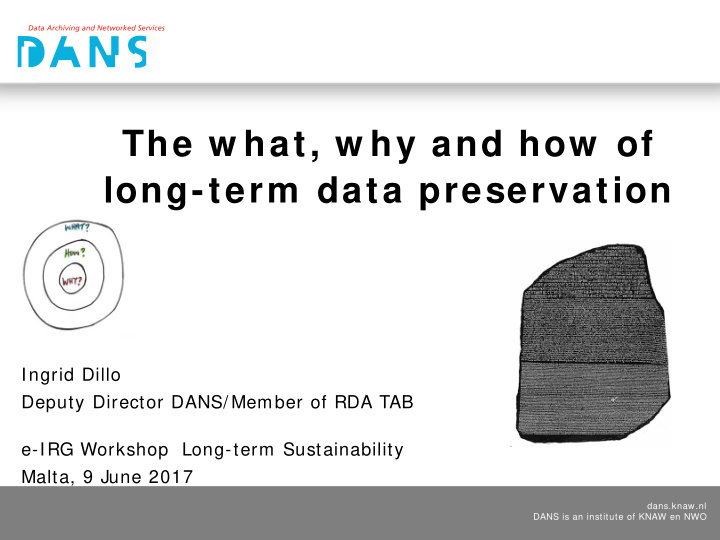



The w hat, w hy and how of long-term data preservation Ingrid Dillo Deputy Director DANS/ Member of RDA TAB e-IRG Workshop Long-term Sustainability Malta, 9 June 2017 dans.knaw.nl DANS is an institute of KNAW en NWO
DANS organisation Mission: promote and provide permanent access to digital research resources Institute of First predecessor Dutch Academy dates back to and Research 1964 (Steinmetz F unding Foundation), O rganisation Historical Data (KNAW & NWO) Archive 1989 since 2005
DANS core services https://dans.knaw.nl EASY Certified Long- term Archive NARCIS DataverseNL Portal to support data aggregating storage during research research until information and 10 years after institutional repositories
DANS international connections
DANS international connections
Proliferation of data • Growing recognition of the value of data • Trend of open science/ open data/ data sharing • Funders mandate data stewardship Advantages • Transparency and replication of research (scientific integrity) • Reuse of data (efficiency, return on investment, standing on the shoulders of others)
Policy makers
..but what about the researchers? Source : The State of Open Data, Digital Science Report (2016).Retrieved: December 23, 2016 . Figures have been redrawn from the originals.
Hesitance in reality
Motivations for data sharing
Data sharing incentives • Influence of sharing norms within direct research circle • Professional rewards for data sharing • External drivers: • Publisher requirements (DAPs) • Funder policies/ mandates http: / / repository.jisc.ac.uk/ 5662/ 1/ KE_report-incentives-for- sharing-researchdata.pdf
Other data sharing challenges Enabling the researcher to comply with open data requirements: • awareness raising, training and support for data management (DMPs, FAIR data) • infrastructure for preservation of and long-term access to the data
Sustainable support model Frontoffice-backoffice model • Division of labour • Economies of scale Backoffice • Curation and preservation expertise • Training of local data experts • Long-term preservation infrastructure
“Perhaps the biggest challenge in sharing data is trust: how do you create a system robust enough for scientists to trust that, if they share, their data won’t be lost, garbled, stolen or misused?”
Pillars of trust • actions and attributes of the trustee (integrity, transparency, competence, predictability, guarantees, positive intentions) • external acknowledgements: • reputation (researchers) • third party endorsements (funders, publishers)
The global certification landscape ISO 16363:2012 - Audit and certification of trustworthy digital repositories http://www.iso16363.org/ DIN 31644 standard “Criteria for trustworthy digital archives” http://www.langzeitarchivierung.de http://www.datasealofapproval.org/ https://www.icsu-wds.org/
DANS and Data Seal of Approval • 2005: DANS to promote and provide permanent access to digital research resources • Formulate quality guidelines for digital repositories including DANS • 2009: international DSA Board • Almost 70 seals acquired around the globe, but with a focus on Europe • https: / / www.datasealofapproval.org/ en/
Partnership with WDS under the umbrella of RDA • Goals: • Realizing efficiencies • Simplifying assessment options • Stimulating more certifications • Outcomes: • Common catalogue of requirements for core repository assessment • Common procedures for self-assessment and review process • One new certification body: CoreTrustSeal Board
New CoreTrustSeal Requirements Requirements: • Context (1) • Organizational infrastructure (6) • Digital object management (8) • Technology (2) https://goo.gl/kZb1Ga
The cost of long term preservation
The cost of long term preservation
Sustainable business models for data repositories Increasing need for data repositories and data stewardship. • Increasing volume presents a challenge. • Requirements for stewardship present a greater challenge. Sustaining digital data infrastructure is a major issue for science policy • current funding models will prove inelastic and not meet the growing requirements – concern on the part of repositories and funders
Sustainable business models for data repositories RDA Cost Recovery Interest Group, also supported by WDS and CODATA Report Income Streams for Data Repositories (Feb 2016; https: / / zenodo.org/ record/ 46693# .WTUR-TOB2T8) • based on 25 in-depth interviews, identifying topics and trends, alternative revenue streams
Sustainable business models for data repositories • Continuation of the work under the umbrella of OECD/ GSF • Around 50 interviews in total • Thorough economic analysis • Cost optimization • Stakeholder workshops • Presentation of report and stakeholder recommendations at RDA Plenary Montreal • Expected OECD publication end of 2017 https: / / www.innovationpolicyplatform.org/ open-data-science-oecd-project
Elements of a Business Model for Data Repositories User Base • Data depositors • Data users Developing the • Research institutions Identifying the product mix • Research funders user base • Others Products Financing • Research data • Investment funding • Research facilities • Development funding • Value-adding services • Operational revenue • Contract services • Research services Revenue Sources Understanding Making the • Structural funding cost drivers & value • Host institutional funding matching revenue proposition(s) • Deposit-side charges streams • Access charges • Services charges
Takeaways for the e-IRG LTP Guidelines In order to realise the long-term preservation of data we need: • FAIR data in TDRs • Global network of TDRs • Certification (at least CTS) to create trust • Economic/ organisational sustainability to enable long- term data accessibility
Thank you for listening ingrid.dillo@dans.knaw.nl www.dans.knaw.nl
Recommend
More recommend